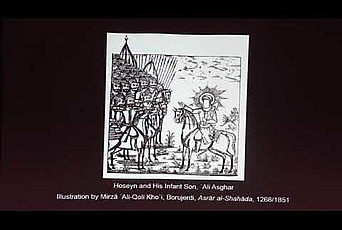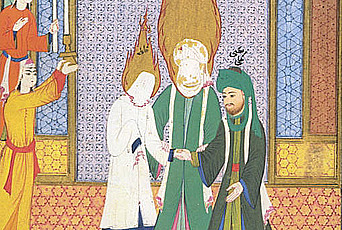This is an abridged version of an interview conducted at the Institute for Advanced Study in Princeton, New Jersey, in connection with the Shii Studies Research Program, supported by Carnegie Foundation, on March 28, 2019. Etan Kohlberg is an emeritus professor at the Hebrew University of Jerusalem and a past Member (1986–87) and Visitor (2000–01) in the School of Historical Studies at the Institute. Edmund Hayes is a researcher at Radboud University in Nijmegen.
A full transcript of the interview is available at this link.
Hayes: Could you tell me a little bit about how you first started to study Arabic at school?
Kohlberg: I grew up in Tel Aviv in the ’40s and ’50s. At the time, high school students could choose between Arabic and French as a second language. I remember being very curious about the Arabic script. I would think, “My goodness, how can one decipher this?!” It looked so difficult and at the same time so beautiful. I had two mentors in high school with two very different personalities: Miriam Solel had come from the German orientalist tradition. She gave us a solid grounding in Arabic grammar, taught us a few of the short Quranic suras, and Islamic history. Avraham Lavi, was born in Tiberias, then a mixed Arab-Jewish city, and he was a native speaker of both Hebrew and Arabic. For him Arabic was not an academic subject but a living language. With him we read Arabic newspapers and literature. He made us speak Arabic in class and would shout at the top of his voice when anyone dared to fall back into Hebrew.

Hayes: Did you have an inkling at that point that you would take the path less travelled to study the medieval period?
Kohlberg: Because Avraham Lavi was such a charismatic character I thought for a while I would continue in his path. But when I came to the Hebrew University in Jerusalem, I realized there was so much to be learned and researched in the medieval period—especially with one particular teacher who led the way… Meir Kister, who was an extraordinary teacher and scholar. His influence was decisive, not only for me, but for a whole generation.
Hayes: So, what was it like, sitting in his classroom?
Kohlberg: You were expected to come to class fully prepared! He would throw stuff at you and expect you to answer, expecting you to have checked every dictionary from Lisān al-ʿarab to Lane. He did not go in for grand theories; instead, he would show you what could be learned from the smallest text unit. And he had this game: if we were sitting in a small group and you didn’t know a word, you had to pay one lira–a pretty small sum of money–and put it in a box. When a sufficiently large amount had accumulated, we all went to the cafeteria and had coffee with the proceeds. His enthusiasm was absolutely infectious and of course his scholarship was amazing. He had a first-year undergraduate class called “Easy Classical Prose Texts,” where the texts studied were the most difficult you could imagine!

Hayes: You are famous for really opening up the field of Shii Studies. Was there any sense at that point that Shiism was something you would be interested in?
Kohlberg: There was no class devoted to Shii Studies, although Moshe Sharon taught a class on the ʿAbbasid revolution which I attended. For my undergraduate seminar paper Kister suggested that I compare the Shii and Sunni views on the accession of Abū Bakr. It was a very important moment, and in fact my doctoral dissertation is, in a way, an offshoot of that initial work.
Hayes: What was it that sparked your interest?
Kohlberg: We normally read Sunni texts. Being exposed to Shii sources made me realize that there was another way of looking at early history, and that fascinated me. There was a whole new world to explore, and I felt a little bit like an adventurer entering uncharted territory.
Hayes: Why did you decide to go to Oxford for your dissertation?
Kohlberg: When I finished my M.A., an edition of two Arabic Sufi texts, Kister suggested that I try a different academic system. He mentioned Samuel Stern, a Research Fellow at All Souls College and Lecturer at the Oriental Institute in Oxford. Kister had known Stern from the early 1940s, when they were both students of the eminent arabist David H. Baneth (1893–1973) at the Hebrew University. Stern was a leading expert on Ismaili Shiism. So, I found myself one bright afternoon in August 1968 knocking at the door of 5 Bladon Close, where Stern lived at the home of Richard and Sophie Walzer. The Walzers had a two-story house and Stern lived on the upper floor. Stern and I usually had our sessions either at their house or at the King’s Arms pub near the New Bodleian.

Richard was Professor of Islamic Philosophy and his wife, herself a good scholar, was the daughter of the German Jewish publisher and gallery owner Bruno Cassirer. The Walzers had a wonderful art collection, presumably inherited from Sophie's father. It included Claude Monet's Bathers at la Grenouillère,1 which visitors to the Walzer home could admire. Nothing was insured, because of the high cost of insurance.
Stern died suddenly on October 29, 1969, less than ten months after my arrival. That was a deeply shocking event, a tragedy for everyone who knew him, and a great loss to the field. He had not yet reached the age of 49.
Hayes: Just from his publications you wouldn’t get the sense that Stern had a short life. He covered so much, he was so curious in so many areas: numismatics, doctrinal history…
Did you finish your dissertation at Oxford and then go back to Jerusalem, or were you still writing when you went back to Jerusalem?
Kohlberg: While I was in Oxford, I received an offer from the Hebrew University to join the Faculty of Humanities as a lecturer in Arabic. I made a big effort to finish and submit the dissertation and have the viva in Oxford before returning home, because I knew that once I got into teaching, I would be quite busy.

Hayes: So now I will move on to some more detailed questions about the study of early Shiism, a field in which your contribution has been so influential. Could you give me an impressionistic sense of who you think the Shii Imams were and what the early Shii community was?
Kohlberg: Needless to say, the Imams were central figures, arguably the most knowledgeable scholars of their day. If you read the biography of Imam Jaʿfar al-Ṣādiq (d. 765 C.E.) in Sunni sources, you realize he was considered a very learned scholar even by those who did not subscribe to the Shii vision of the world. So, it is not surprising that these men had a group of disciples that followed them. Though as we know from reading the early material there were discussions, and sometimes even disagreements between some of the leading disciples and the Imam.
Hayes: So, was the Shii Imam originally mainly a faqīh: a jurisprudent? an “imam” in the sense that the Sunnis use the term, for example “Imam Mālik,” to indicate a great scholar? Is that the kind of imam the Shii Imams were?
Kohlberg: He was a faqīh but also a leader of the community. The question is, at what point was he also believed to be divinely designated or deemed to have supernatural knowledge or connections to the divine that went beyond being just a leader? And when exactly was it that his disciples started viewing him in this way? I imagine it was quite early, though it's hard to put a precise date on it: At the latest during the lifetime of Jaʿfar al-Ṣādiq. His imamate lasted for 34 years and coincided with the transition from the Umayyads to the ʿAbbasids. He was clearly an extraordinary personality. A great many legal hadiths [normative statements of Islamic dogma] go back to him.
We still need more critical editions. I would insist, being old-fashioned in my way, that you cannot achieve significant results without having a solid basis in the text. The text is where we start, and then we can take it where we want. —Etan Kohlberg
Hayes: One of the great differences between Shii hadith and Sunni hadith is that at the time when the Sunnis started feeling that all the hadith should go back to the Prophet Muḥammad, the Shiʿa had accepted that hadith that go back to the Imams were sufficient as a base of law.
Kohlberg: Or just as authoritative. In principle hadith fulfills the same function for Sunnis and Shiis, and serves as the basis of the law. A key difference is that for Shiis the Imams have the same authority as the Prophet Muḥammad.
The Imams’ membership of the ahl al-bayt, the family of the Prophet, was a prerequisite for their ʿisma, [infallibility or impeccability] and their possession of both legal authority and esoteric knowledge.
Hayes: Coming back to this question of dissent from the Imams, how do you feel disagreement with the Imam might have operated?
Kohlberg: Dissent may have been more acceptable in the earlier period, and there are some indications that the Imams encouraged their disciples to express their own views. One hears less about disagreements with the later Imams, possibly because by that time the doctrine of ʿisma had been firmly established, though there were dissenting voices at that time as well.
Hayes: Finally, what tips would you give for scholarship in the field?
Kohlberg: We still need more critical editions. I would insist, being old-fashioned in my way, that you cannot achieve significant results without having a solid basis in the text. The text is where we start, and then we can take it where we want.
Further reading: There is an overview of Etan Kohlberg’s career and life in the Introduction/Foreword by Frank Stewart, in M.A. Amir-Moezzi, M.M. Bar-Asher, S. Hopkins (eds.), Le shiʿisme imamite quarante ans après. Hommage à Etan Kohlberg (Turnhout: Brepols, 2009).
A recently published book collects many of Kohlberg's earlier studies, both published and unpublished: In Praise of the Few: Studies in Shiʿi Thought and History, edited by Amin Ehteshami (Leiden: Brill 2020).
1 See https://www.nationalgallery.org.uk/paintings/claude-monet-bathers-at-la-grenouillere#



